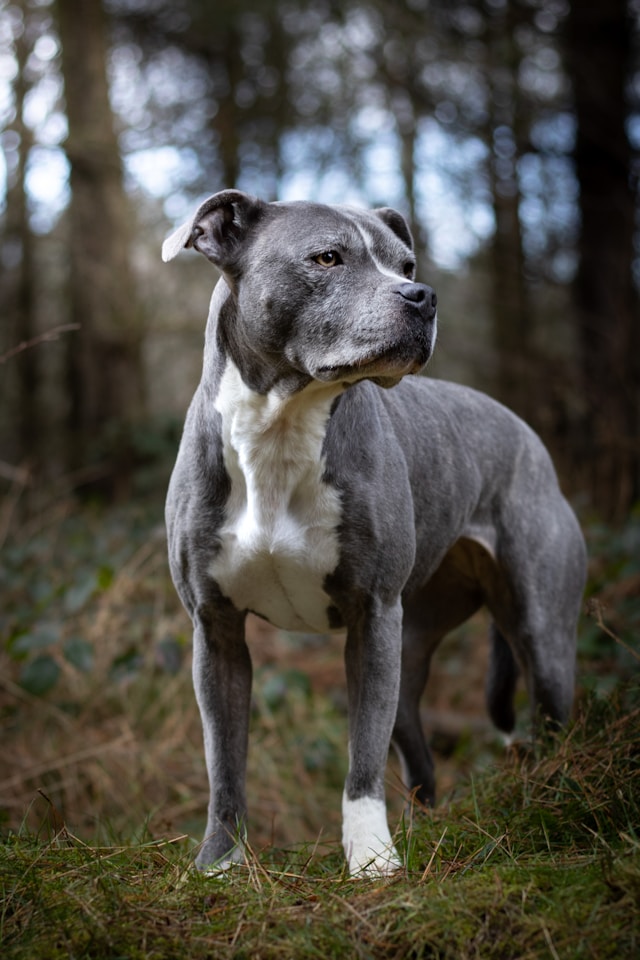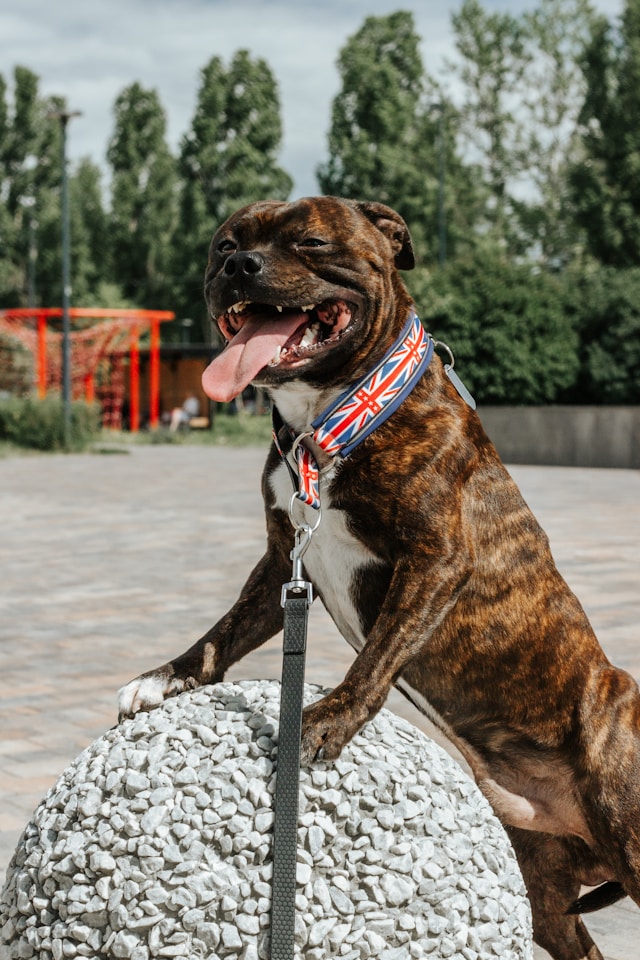If you’ve been hearing whispers about the Blue Staffy and wondering what all the fuss is about, you’re in the right place. The Blue Staffy, or Blue Staffordshire Bull Terrier, is a striking and lovable breed that’s stealing hearts left and right. Known for their unique blue-gray coat and muscular build, these dogs are a standout in the canine world. But there’s so much more to a Blue Staffy dog than just their looks—they’re loyal, energetic, and full of personality. In this guide, I’m going to walk you through everything you need to know about this amazing breed, from their history to tips on finding Blue Staffy puppies for sale.

So, why is the Blue Staffy gaining so much popularity? Well, for starters, their stunning appearance turns heads wherever they go. Plus, their affectionate nature and adaptability make them a fantastic fit for many families. Whether you’re a seasoned dog owner or a first-timer, the Staffy Blue might just be the companion you’ve been dreaming of. Stick with me, and let’s dive into what makes this breed so special!
What is a Blue Staffy?
Let’s get down to the basics. The Blue Staffy is a variation of the Staffordshire Bull Terrier, a breed that hails from England. Originally bred in the 19th century for bull-baiting (a sport that’s thankfully long gone), these dogs were later used for dog fighting before becoming the beloved family pets we know today. The “blue” in Blue Staffy refers to their unique coat color—a diluted black that appears as a gorgeous slate gray or blue hue. This isn’t just any Staffy; the Blue Staffy dog stands out with a look that’s both rugged and refined.
Now, let’s talk temperament. If you’re picturing a tough, aggressive dog because of their history, think again! The Staffy Blue is often described as a “nanny dog” because of their gentle and protective nature, especially around kids. They’re incredibly loyal, love to cuddle, and have a playful streak that’ll keep you entertained for hours. Sure, they’ve got a muscular build and a strong jaw, but their heart is pure gold. Just remember, they’re energetic and need an owner who can keep up with their zest for life.
Physical Traits of a Blue Staffy Dog
Alright, let’s chat about what makes the Blue Staffy so visually striking. Their coat is the star of the show—smooth, short, and that signature blue-gray color that almost shimmers in the sunlight. It’s not just pretty; it’s also low-maintenance, which is a win for busy owners. A quick brush once a week and the occasional bath will keep your Blue Staffy looking sharp. But here’s a heads-up: that unique blue color can sometimes come with a risk of skin issues, so keep an eye out for any irritation.
Size-wise, a Blue Staffy dog is compact but powerful. They typically stand between 14 to 16 inches tall at the shoulder and weigh anywhere from 24 to 38 pounds, with males being a bit larger than females. Their build is all muscle, giving them a stocky, athletic look that screams strength. Despite their tough appearance, they’ve got these expressive eyes and a cheeky grin that’ll melt your heart. If you’re considering Blue Staffy puppies, know that they start off as tiny bundles of energy but grow into these robust, handsome dogs pretty quickly.
Blue Staffy Puppies: What to Know Before Bringing One Home
Speaking of Blue Staffy puppies, let’s talk about what it’s like to bring one of these little cuties into your life. First off, they’re adorable—those big eyes and floppy ears are hard to resist. But don’t let their charm fool you; Blue Staffy puppies are a handful! They’re full of energy and curiosity, so you’ll need to be ready for chewed shoes and endless playtime. They also crave attention, so if you’re not around much, this might not be the breed for you.
When picking out a Blue Staffy puppy for sale, health should be your top priority. Look for pups with clear eyes, clean ears, and a shiny coat. Ask the breeder for health clearances for the parents, especially for conditions like hip dysplasia or hereditary cataracts, which can affect the breed. A good breeder will be transparent and happy to answer all your questions about their Blue Staffy puppies for sale. Trust your gut—if something feels off, walk away. These pups deserve the best start in life, and so do you as their new owner.
Finding Blue Staffy Puppies for Sale
So, you’re sold on the idea of a Blue Staffy and ready to find one. Awesome! But where do you start looking for Blue Staffy puppies for sale? The internet is a great place to begin—check out reputable websites like the American Kennel Club (AKC) or local breed clubs for breeder directories. Social media groups dedicated to Staffordshire Bull Terriers can also point you in the right direction. Just be cautious of scams or puppy mills when searching online for a Blue Staffy puppy for sale. If a deal seems too good to be true, it probably is.
Another option is to attend dog shows or events in your area. You might meet breeders who have Blue Staffy puppies available or can put you on a waiting list. Word of mouth works wonders too—ask friends, family, or even your vet if they know of any reputable sources for Blue Staffy puppies for sale. And hey, don’t rule out rescues! Sometimes, you can find a Staffy Blue in need of a loving home through a shelter or breed-specific rescue organization. Adopting can be just as rewarding as buying a pup.
Blue Staffy Puppies Near Me: Local Search Tips
If you’re specifically looking for Blue Staffy puppies near me, I’ve got some tips to make your search easier. Start by checking local classifieds or community boards—sometimes, breeders post about Blue Staffy puppies for sale near me right in your neighborhood. Pet stores might also have leads, though I’d steer clear of buying directly from them since many source from puppy mills. Instead, ask if they know of local breeders with Blue Staffy puppies near me.
One big perk of finding Blue Staffy puppies for sale near me is that you can visit the breeder in person. Seeing where the pups are raised and meeting the parents (at least the mom) gives you peace of mind about their upbringing. Plus, you save on travel or shipping costs, and you can start bonding with your new Blue Staffy puppy right away. Local adoption also means you’re supporting nearby breeders who often prioritize the health and well-being of their dogs over mass production.
Caring for Your Blue Staffy Puppy
Once you’ve got your Blue Staffy puppy home, it’s time to roll up your sleeves and get to work. Feeding is a big deal—these pups need a high-quality diet to support their growth and energy levels. Look for puppy food formulated for medium-sized breeds with plenty of protein and nutrients. Avoid overfeeding, though; Blue Staffy puppies can pack on pounds quickly if you’re not careful, and extra weight can strain their joints. Chat with your vet about portion sizes and feeding schedules to keep your Staffy Blue in tip-top shape.
Training and socialization are just as important as diet. Start early with basic commands like “sit” and “stay,” and use positive reinforcement—Blue Staffy puppies respond best to treats and praise. Get them out and about to meet other dogs and people, too. A well-socialized Blue Staffy dog grows up confident and friendly, not anxious or reactive. And don’t skimp on exercise! These pups need daily walks, playtime, and mental stimulation to burn off their boundless energy. Trust me, a tired Blue Staffy is a happy Blue Staffy.
Health Concerns for the Blue Staffy Dog
Let’s talk about something a bit more serious—health. Like any breed, the Blue Staffy dog can be prone to certain issues. One thing to watch for is skin allergies, especially since their unique blue coat can sometimes be linked to a genetic condition called Color Dilution Alopecia. This can cause hair loss or flaky skin, so regular vet checkups are a must. Hip dysplasia, cataracts, and heart conditions are other concerns to keep on your radar for a Staffy Blue.
Preventative care is your best friend here. Keep up with vaccinations, flea and tick prevention, and dental cleanings to avoid bigger problems down the road. A healthy diet, regular exercise, and not skipping those vet visits will go a long way in ensuring your Blue Staffy lives a long, happy life. If you’ve got Blue Staffy puppies, start these habits early—building a strong foundation now means fewer worries later. And always ask your breeder about the health history of the parents when looking for Blue Staffy puppies for sale.
Is a Blue Staffy Right for You?
Before you rush out to find Blue Staffy puppies near me, let’s make sure this breed is the right match for your lifestyle. Blue Staffy dogs are high-energy and need owners who can commit to daily exercise—think long walks, fetch sessions, or even agility training. If you’re a couch potato, this might not be the dog for you. They also thrive on companionship, so if you’re away from home a lot, they could get lonely or destructive.
The ideal home for a Blue Staffy puppy for sale is one with space to play, whether that’s a fenced yard or nearby parks. They do well in families with kids, thanks to their gentle nature, but supervision is key with younger children since these dogs can be a bit boisterous. Apartments can work too, as long as you’re dedicated to meeting their exercise needs. Ultimately, a Blue Staffy dog wants to be part of your pack—give them love, structure, and activity, and they’ll repay you with endless devotion.
Conclusion
So, there you have it—everything you need to know about the incredible Blue Staffy breed. From their eye-catching blue-gray coat to their loving, playful personality, the Blue Staffy dog is truly one of a kind. Whether you’re drawn to their history as tough-but-tender companions or just can’t resist those adorable Blue Staffy puppies, this breed has a lot to offer. Just remember, owning a Staffy Blue comes with responsibility—they need exercise, training, and plenty of TLC to thrive.
If you’re ready to welcome a Blue Staffy puppy for sale into your life, take your time to find a reputable breeder or consider adoption. Search for Blue Staffy puppies for sale near me to connect with local options, and don’t hesitate to ask questions to ensure you’re getting a healthy, happy pup. I hope this guide has helped you decide if a Blue Staffy is your perfect match. If it is, get ready for a loyal, fun-loving friend who’ll stick by your side through thick and thin!

